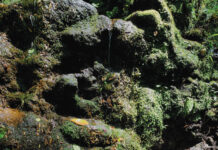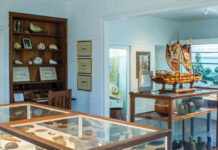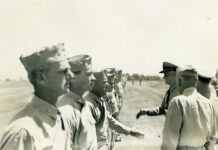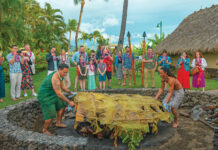Aboard the brig Thaddeus, that first company included the Reverends Hiram Bingham and Asa Thurston, three Hawaiians, and Elisha Loomis, printer. With Loomis came a Ramage press, a modest wooden contraption that used metal type, laid out letter by letter, to create a printed page.
“People think the missionaries got off the ships and started barking orders,” says Dr. Puakea Nogelmeier, graduate chair of Kawaihuelani Center for Hawaiian Language at the University of Hawai‘i–Manoa. “They were allowed to land, but not paid attention to for a while.” What they had that interested Hawaiians, says Nogelmeier, “was not religion, but literacy, and the willingness to teach.
“They get here, and there’s been forty years of interaction already. Hawaiians have been watching people think something, write it down, give it to someone else, and have that person understand. That was power, and the Hawaiians embraced it.”
Even before the missionaries, a school had been established for the children of Kamehameha the Great, first chief to unite the Islands. After his death in 1819, and that of his son Liholiho in 1824, Liholiho’s younger brother Kauikeaouli ascended the throne in 1825, at the tender age of eleven. His first proclamation, says Nogelmeier, was, “My kingdom will be a land of literacy.”
The young king’s aspirations jibed perfectly with those of the American Board. In the span of a single lifetime, Hawai‘i transformed from a nonliterate to an almost universally literate society. By 1822, with the creation of a Hawaiian alphabet, Elisha Loomis began printing works that would teach Hawaiians not only to read, but to learn in translation mathematics, science, philosophy, and of course, scripture.
Nine years later, Lahainaluna Seminary opened to train adult Hawaiians as teachers. In 1834, the old Ramage press arrived from Honolulu and took up residence in a thatch-roofed building on the school’s grounds. By 1837, Hale Pa‘i boasted three printing presses and a new structure built of fieldstone, timber and coral.
Most of the works printed at Hale Pa‘i were books for use at Lahainaluna. The school’s first principal, Rev. Lorrin Andrews, himself compiled a Hawaiian vocabulary and grammar, and translated more than a dozen books, among them Linear Drawing, Maps of Sacred Geography, First Lessons in Geometry and Animals of the Earth. Andrews ran the print shop’s office and bindery, and taught students copperplate engraving for maps. The students also learned to engrave on sandalwood, creating illustrations for books.





